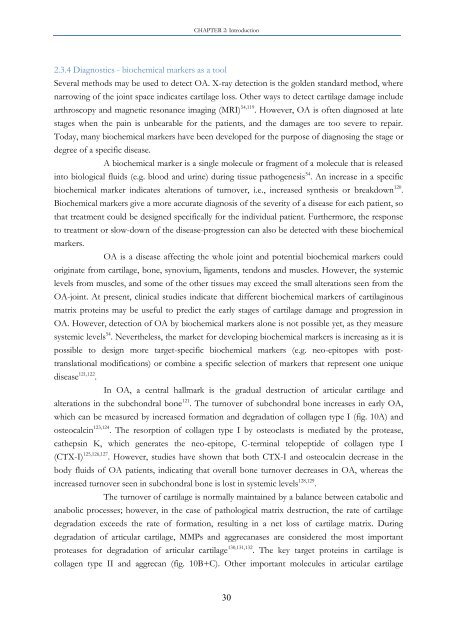Identification of important interactions between subchondral bone ...
Identification of important interactions between subchondral bone ...
Identification of important interactions between subchondral bone ...
You also want an ePaper? Increase the reach of your titles
YUMPU automatically turns print PDFs into web optimized ePapers that Google loves.
CHAPTER 2: Introduction<br />
2.3.4 Diagnostics - biochemical markers as a tool<br />
Several methods may be used to detect OA. X-ray detection is the golden standard method, where<br />
narrowing <strong>of</strong> the joint space indicates cartilage loss. Other ways to detect cartilage damage include<br />
arthroscopy and magnetic resonance imaging (MRI) 54,119 . However, OA is <strong>of</strong>ten diagnosed at late<br />
stages when the pain is unbearable for the patients, and the damages are too severe to repair.<br />
Today, many biochemical markers have been developed for the purpose <strong>of</strong> diagnosing the stage or<br />
degree <strong>of</strong> a specific disease.<br />
A biochemical marker is a single molecule or fragment <strong>of</strong> a molecule that is released<br />
into biological fluids (e.g. blood and urine) during tissue pathogenesis 54 . An increase in a specific<br />
biochemical marker indicates alterations <strong>of</strong> turnover, i.e., increased synthesis or breakdown 120 .<br />
Biochemical markers give a more accurate diagnosis <strong>of</strong> the severity <strong>of</strong> a disease for each patient, so<br />
that treatment could be designed specifically for the individual patient. Furthermore, the response<br />
to treatment or slow-down <strong>of</strong> the disease-progression can also be detected with these biochemical<br />
markers.<br />
OA is a disease affecting the whole joint and potential biochemical markers could<br />
originate from cartilage, <strong>bone</strong>, synovium, ligaments, tendons and muscles. However, the systemic<br />
levels from muscles, and some <strong>of</strong> the other tissues may exceed the small alterations seen from the<br />
OA-joint. At present, clinical studies indicate that different biochemical markers <strong>of</strong> cartilaginous<br />
matrix proteins may be useful to predict the early stages <strong>of</strong> cartilage damage and progression in<br />
OA. However, detection <strong>of</strong> OA by biochemical markers alone is not possible yet, as they measure<br />
systemic levels 54 . Nevertheless, the market for developing biochemical markers is increasing as it is<br />
possible to design more target-specific biochemical markers (e.g. neo-epitopes with post-<br />
translational modifications) or combine a specific selection <strong>of</strong> markers that represent one unique<br />
disease 121,122 .<br />
In OA, a central hallmark is the gradual destruction <strong>of</strong> articular cartilage and<br />
alterations in the <strong>subchondral</strong> <strong>bone</strong> 121 . The turnover <strong>of</strong> <strong>subchondral</strong> <strong>bone</strong> increases in early OA,<br />
which can be measured by increased formation and degradation <strong>of</strong> collagen type I (fig. 10A) and<br />
osteocalcin 123,124 . The resorption <strong>of</strong> collagen type I by osteoclasts is mediated by the protease,<br />
cathepsin K, which generates the neo-epitope, C-terminal telopeptide <strong>of</strong> collagen type I<br />
(CTX-I) 125,126,127 . However, studies have shown that both CTX-I and osteocalcin decrease in the<br />
body fluids <strong>of</strong> OA patients, indicating that overall <strong>bone</strong> turnover decreases in OA, whereas the<br />
increased turnover seen in <strong>subchondral</strong> <strong>bone</strong> is lost in systemic levels 128,129 .<br />
The turnover <strong>of</strong> cartilage is normally maintained by a balance <strong>between</strong> catabolic and<br />
anabolic processes; however, in the case <strong>of</strong> pathological matrix destruction, the rate <strong>of</strong> cartilage<br />
degradation exceeds the rate <strong>of</strong> formation, resulting in a net loss <strong>of</strong> cartilage matrix. During<br />
degradation <strong>of</strong> articular cartilage, MMPs and aggrecanases are considered the most <strong>important</strong><br />
proteases for degradation <strong>of</strong> articular cartilage 130,131,132 . The key target proteins in cartilage is<br />
collagen type II and aggrecan (fig. 10B+C). Other <strong>important</strong> molecules in articular cartilage<br />
30

















